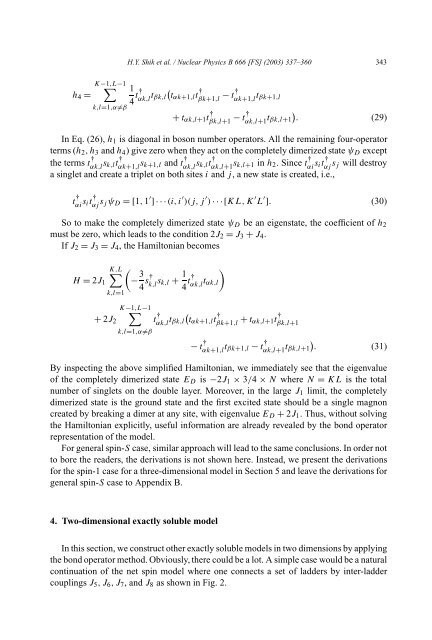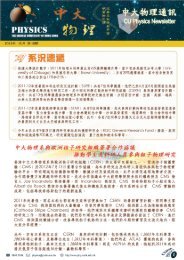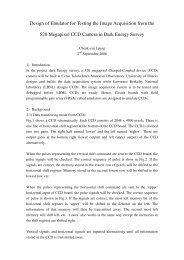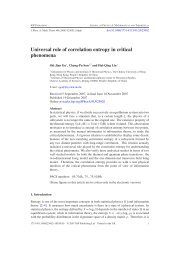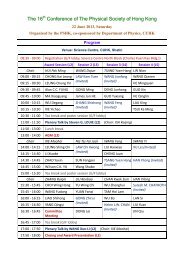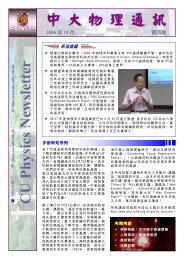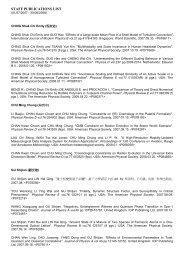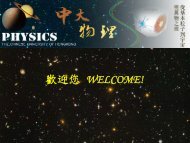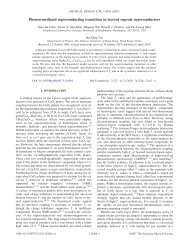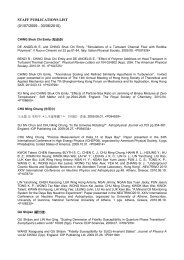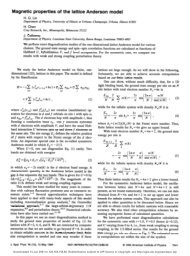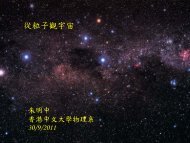Constructing soluble quantum spin models - Department of Physics ...
Constructing soluble quantum spin models - Department of Physics ...
Constructing soluble quantum spin models - Department of Physics ...
Create successful ePaper yourself
Turn your PDF publications into a flip-book with our unique Google optimized e-Paper software.
H.Y. Shik et al. / Nuclear <strong>Physics</strong> B 666 [FS] (2003) 337–360 343<br />
h 4 =<br />
K−1,L−1<br />
∑<br />
k,l=1,α≠β<br />
1<br />
4 t† αk,l t (<br />
βk,l tαk+1,l t † βk+1,l − t† αk+1,l t βk+1,l<br />
+ t αk,l+1 t † βk,l+1 − t† αk,l+1 t βk,l+1)<br />
.<br />
(29)<br />
In Eq. (26), h 1 is diagonal in boson number operators. All the remaining four-operator<br />
terms (h 2 ,h 3 and h 4 ) give zero when they act on the completely dimerized state ψ D except<br />
the terms t † αk,l s k,lt † αk+1,l s k+1,l and t † αk,l s k,lt † αk,l+1 s k,l+1 in h 2 .Sincet † αi s it † αj s j will destroy<br />
a singlet and create a triplet on both sites i and j, a new state is created, i.e.,<br />
t † αi s it † αj s j ψ D =[1, 1 ′ ]···(i, i ′ )(j, j ′ ) ···[KL,K ′ L ′ ].<br />
(30)<br />
So to make the completely dimerized state ψ D be an eigenstate, the coefficient <strong>of</strong> h 2<br />
must be zero, which leads to the condition 2J 2 = J 3 + J 4 .<br />
If J 2 = J 3 = J 4 , the Hamiltonian becomes<br />
∑K,L<br />
H = 2J 1<br />
k,l=1<br />
K−1,L−1<br />
∑<br />
+ 2J 2<br />
(<br />
− 3 4 s† k,l s k,l + 1 )<br />
4 t† αk,l t αk,l<br />
k,l=1,α≠β<br />
t † αk,l t βk,l(<br />
tαk+1,l t † βk+1,l + t αk,l+1t † βk,l+1<br />
− t † αk+1,l t βk+1,l − t † αk,l+1 t βk,l+1)<br />
.<br />
(31)<br />
By inspecting the above simplified Hamiltonian, we immediately see that the eigenvalue<br />
<strong>of</strong> the completely dimerized state E D is −2J 1 × 3/4 × N where N = KL is the total<br />
number <strong>of</strong> singlets on the double layer. Moreover, in the large J 1 limit, the completely<br />
dimerized state is the ground state and the first excited state should be a single magnon<br />
created by breaking a dimer at any site, with eigenvalue E D + 2J 1 . Thus, without solving<br />
the Hamiltonian explicitly, useful information are already revealed by the bond operator<br />
representation <strong>of</strong> the model.<br />
For general <strong>spin</strong>-S case, similar approach will lead to the same conclusions. In order not<br />
to bore the readers, the derivations is not shown here. Instead, we present the derivations<br />
for the <strong>spin</strong>-1 case for a three-dimensional model in Section 5 and leave the derivations for<br />
general <strong>spin</strong>-S case to Appendix B.<br />
4. Two-dimensional exactly <strong>soluble</strong> model<br />
In this section, we construct other exactly <strong>soluble</strong> <strong>models</strong> in two dimensions by applying<br />
the bond operator method. Obviously, there could be a lot. A simple case would be a natural<br />
continuation <strong>of</strong> the net <strong>spin</strong> model where one connects a set <strong>of</strong> ladders by inter-ladder<br />
couplings J 5 ,J 6 ,J 7 ,andJ 8 as shown in Fig. 2.


